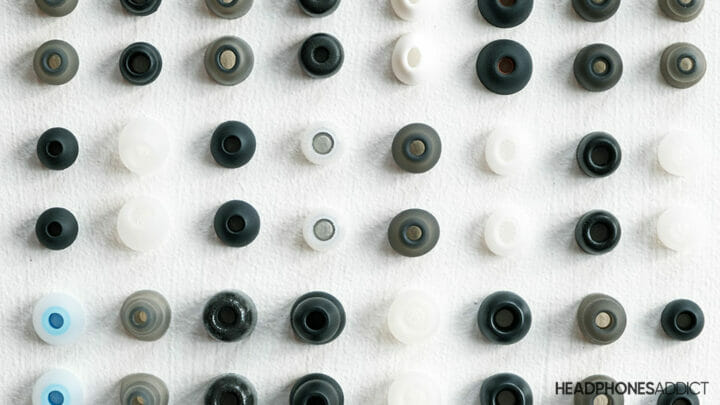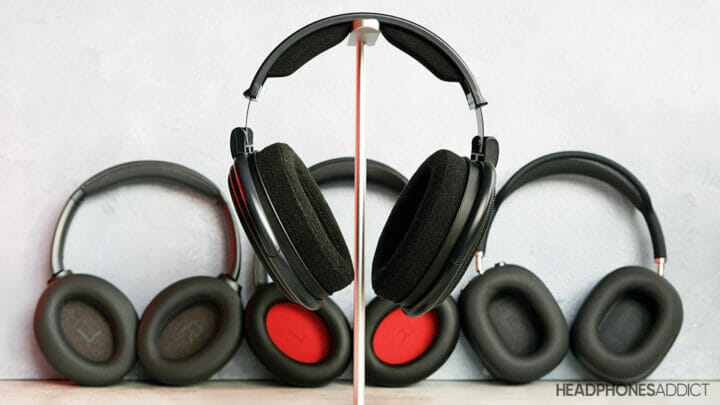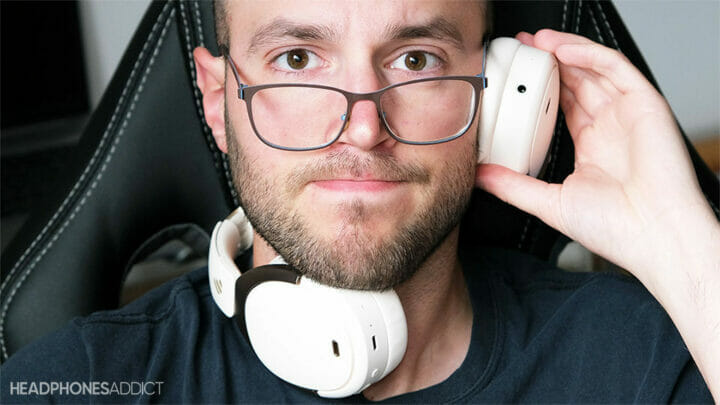If the sound quality on your headphones is getting worse, and the ear pads are stiff and uncomfortable.
For some, this is a sign to buy new headphones. But you might just need to change the ear pads. Check all the types and their pros & cons below.
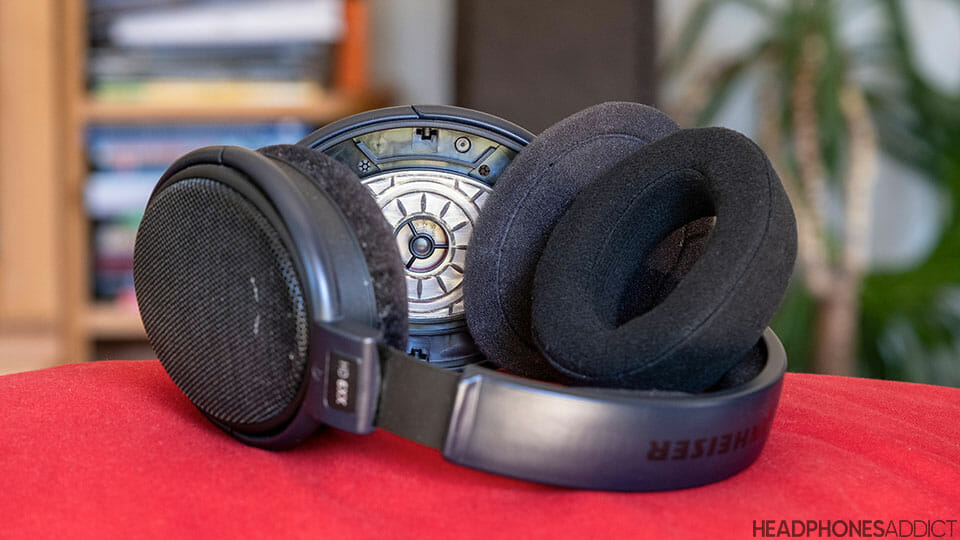
Headphone ear pads, also known as ear cushions, or just pads, are one of the important parts of headphones. Earpads come in many shapes, sizes, and different materials. All of that influences how headphones perform and feel.
In this article, you’ll find:
- Why are earpads important?
- How do they impact the quality of headphones?
- What are the most common ear pad materials?
- How to maintain earpads to extend their lifespan?
- When to replace them?
- What to look for when buying a new pair of earpads?
Types of Headphone Ear Pads
Types of headphone ear pads are mostly different in material and thickness. This affects comfort, sound quality, and durability.
Some are better for passive noise isolation and bass response, while others are more breathable and feel better on your skin.
Also, some materials require proper care. Otherwise, they lose their structural integrity. It can lead to poor-sounding and uncomfortable headphones.
Synthetic leather (faux leather, pleather, PU leather)
Synthetic leather is the most common material for headphone ear pads. It’s soft and pleasant to the touch and easy to clean but suffers from a limited lifespan due to peeling. More on this later.
- Comfortable
- Easy to clean
- Affordable
- Improve bass response
- Good passive noise isolation
- Start peeling over time
- Not breathable and sweat-inducing
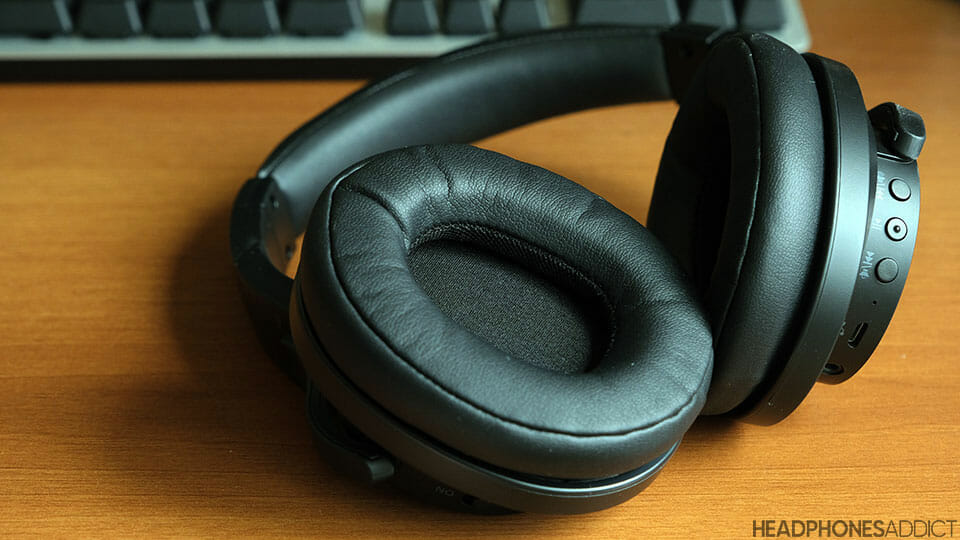
Synthetic ear pads are also known as vegan, protein, pleather, or PU leather.
Artificial leather is excellent for passive noise isolation. It creates a good seal, preventing noise from going in or out of the cups. Better isolation also benefits bass response, amplifying the low-end resonance that reaches the deep sub-bass.
However, that comes at the cost of breathability. An excellent seal prevents the circulation of air. That is why you start sweating soon after putting them on. Excess sweat ends up on the leather itself, so it’s a bit annoying.
Not all faux leather ear pads are the same
Higher-quality synthetic ear pads are softer and last a bit longer.
PU leather is a higher-quality synthetic material. It stands for polyurethane leather. But while it may last a bit longer than cheaper materials, it will still peel over time.
Even the best quality synthetic ear pads eventually start peeling.
The cheaper pleather pads, PVC and vinyl, also feel soft to the touch but often crack early (like the stock pads on Samson SR850).
How long do synthetic leather ear pads last?
You should expect around 2 years of use from your faux leather pads if you wear your headphones daily. The overall lifespan depends on the hours worn.
If you’re a heavy user who wears headphones for hours each day, then expect a shorter lifespan. And by “shorter lifespan” I mean the ear pads will start peeling.
Technically you can still keep using headphone earpads that peel, but it’s a messy experience. Your headphones will leave small black pieces of earpad material around your ears.
What to do with peeling headphone pads?
The only way to fix peeling headphone pads is to replace them. Unfortunately, there’s no easier fix. Once the pads start peeling and chaffing, there’s no way to get them back to their original form.
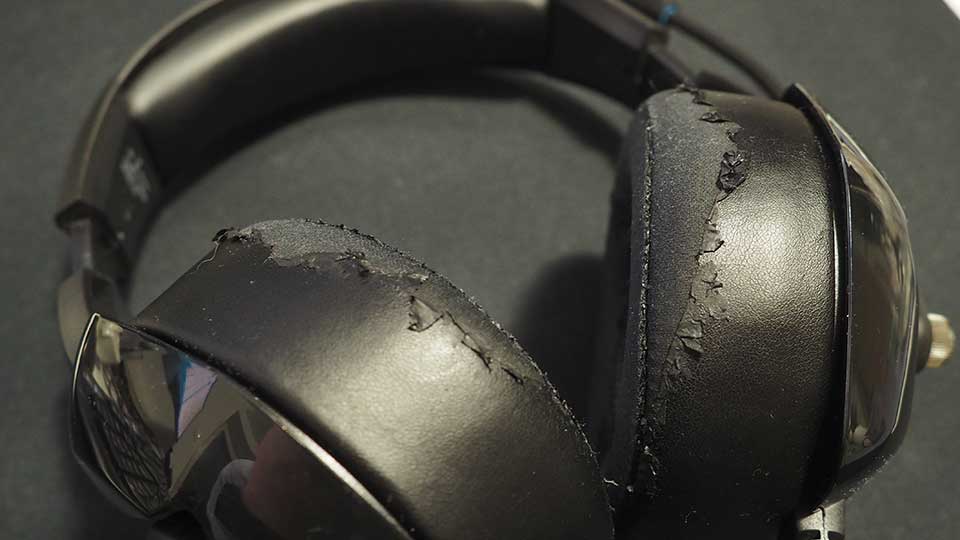
How to maintain synthetic ear pads?
- Wipe your ear pads after every use with a cloth or by quickly brushing them against your shirt
- Don’t expose your headphones to extreme temperatures (leaving them in the sun)
Thankfully, synthetic leather is very easy to maintain. It’s advised that you wipe the earpads with a cloth (or shirt) every time you stop using your headphones. Otherwise, dirt will start to build up.
Keep in mind that faux leather doesn’t like extreme environmental conditions. For example, don’t leave headphones in direct sunlight or exposed to heat and humidity. If you don’t use your headphones regularly, it’s probably a good idea to store them inside a box or a pouch. That way, you slow down earpad degradation.
Fabric
Fabric headphone ear pads are popular among gaming headsets thanks to their breathability. They offer a comfortable wearing experience and a longer lifespan. But they suffer from poor passive noise isolation and accumulation of dirt over time.
- Comfortable
- Breathable and cool
- Sweat-free
- Long lifespan
- Poor passive noise isolation
- Can get dirty and smelly
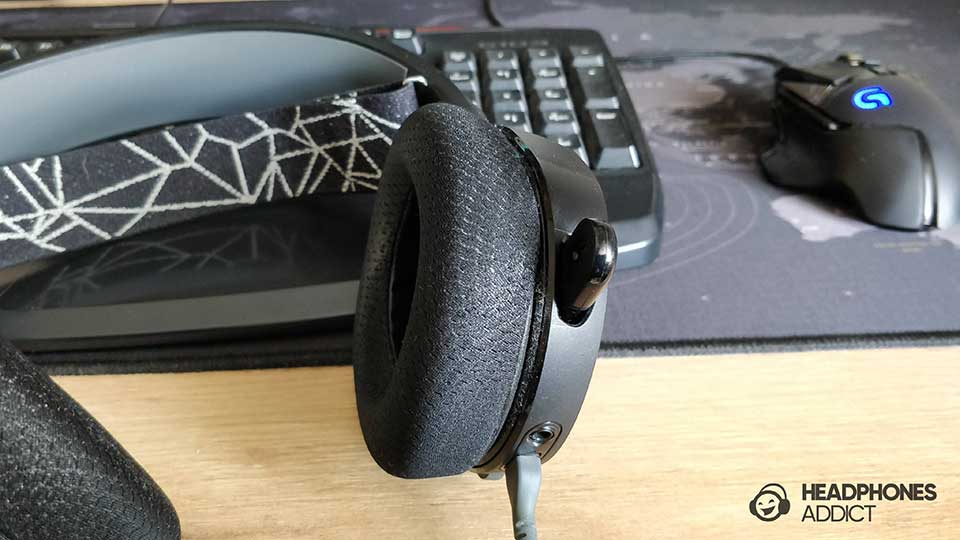
The soft fabric material is comfortable and provides ample cushioning to the ear cups. And with increased breathability, they’re the perfect choice for those who suffer from hot ears when wearing headphones.
Thanks to the airflow going through the ear pads, the heat can escape the inside of the ear cup.
But the breathability has its cost. Fabric ear pads let more background noise through. This means they let in more ambient noise and leak out more sound.
For a gaming headset where you play alone, this usually isn’t a problem. But it might be a concern for listening to headphones in public.
How long do fabric ear pads last?
Fabric headphone pads never peel because it’s a completely different material. So, as long as you clean them regularly, they can last for the whole headphone lifespan.
But you have to clean them. The fabric has many empty pockets for the air to go through but also for dirt to attach. This makes them more dirt-prone than other types of ear pads.
How to maintain fabric headphone pads?
- Wipe down the ear pads after use with a cloth
- If detachable, hand wash the fabric ear pads with soft clothes detergent
- Wash your hair regularly to lower the dirt intake
The only way to keep fabric headphone pads clean is to wash them by hand with a soft laundry detergent. This takes a bit more effort, but it keeps your pads clean and in good condition.
Velour
Velour headphone ear pads are similar to fabric but plusher. They’re usually found in professional studio headphones and open-back headphones. The level of passive noise isolation depends on the thickness of the knit. So, usually, they isolate better than loosely knit fabric ear pads.
- Comfortable and plush
- Long lifespan
- Good passive noise isolation
- Don’t induce sweating
- Poorer breathability than fabric pads
- Easier to get dirty and smelly
- Won’t get them on cheap headphones
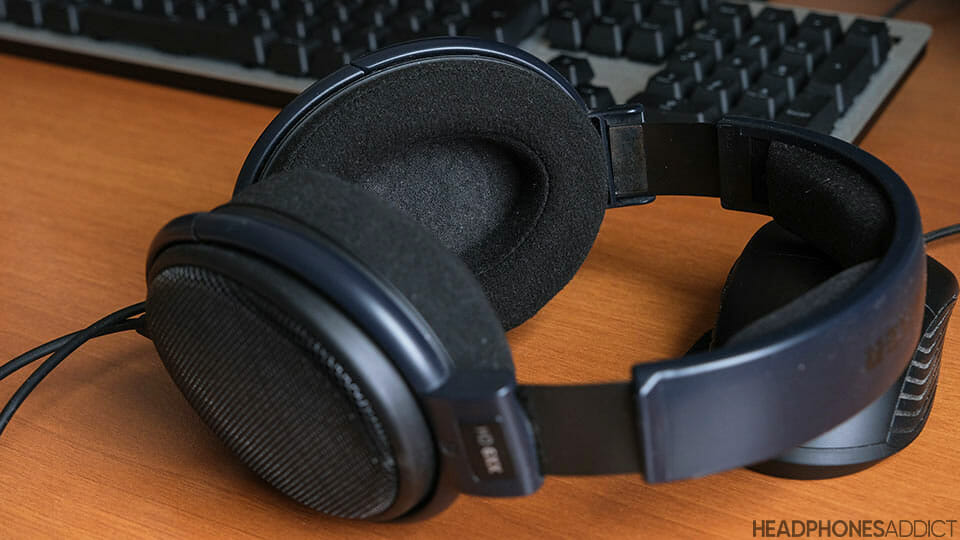
If you need headphones for extended listening sessions, velour is the best choice. Velour headphone pads feel soft to the touch, and don’t induce sweat or irritate the skin.
They create a decent seal, but can make the sound signature a bit brighter and airier. This is also the reason why they’re popular on audiophile open-back headphones.
While noise isolation is better than with loosely knit fabric earpads (we see on gaming headsets), it isn’t as good as with faux leather.
Velour earpads don’t peel, so if you keep them in good condition, they can last almost forever. Or at least until the foam inside loses structural integrity, which can take many years.
But the bad thing about velour pads is that they get smelly if you don’t clean them. Velour picks up more dust and dirt due to its plush fibers.
And you won’t get them on cheap headphones. You have to buy replacement earpads and replace and install them yourself, if possible. Some headphones don’t have replaceable pads.
How to maintain velour ear pads?
It’s the same as as for fabric earpads:
- Wipe down ear pads with a cloth
- If detachable, hand wash them with a soft laundry detergent
- Wear headphones with clean hair to lower the dirt intake
- Dirt on your skin can find its way onto ear pads, so keep your face clean
- Avoid direct sunlight
Velour likes to pick up a lot of dirt and dust, and since it’s a very porous material, any sweat gets easily absorbed inside the ear pads. Sweat attracts dirt, and both create an odor after some time.
To keep velour pads fresh, wash them when they develop a bad smell.
As with leather pads, it’s advised to wipe them with a cloth or a shirt as soon as you stop using them. After you gently clean them, let them dry in the air. Please don’t squeeze the pads since it can damage the internal structure of the foam inside.
Also, to prevent direct sunlight and dust damage, you should consider placing them in a dedicated box or carrying pouch. They will last longer and look better.
Real leather
Real leather headphone ear pads are the most luxurious and expensive. People don’t only pay for the sound, but also for the experience. Some like it because of the “leathery” smell, but real leather has its advantages. With proper maintenance, it lasts longer than synthetic earpads.
- Comfortable – real leather feel
- Great passive noise isolation
- Can get hot
- Long lifespan
- Sweat inducing
- Require special maintenance
- Expensive
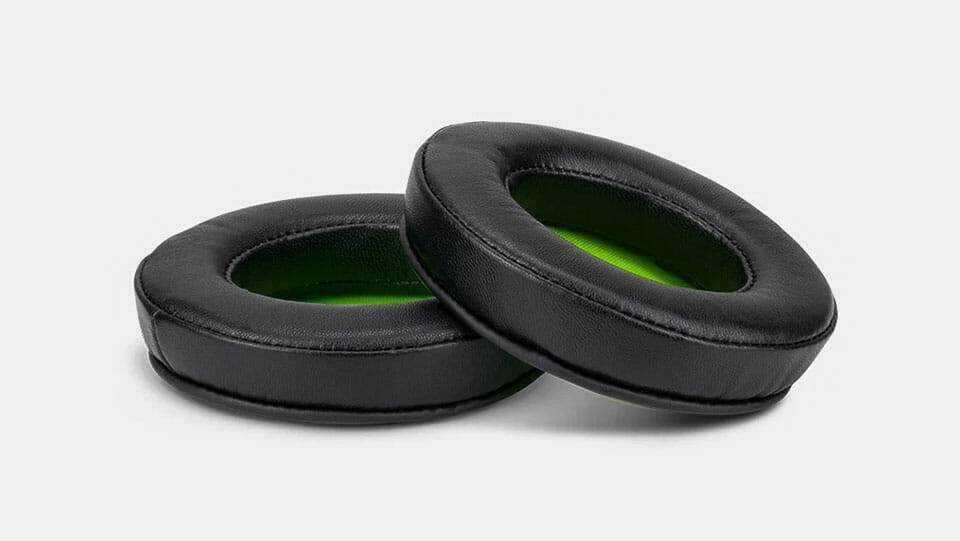
Real animal skin leather is much rarer than synthetic and offers superior durability but for a higher price.
The most common is sheepskin leather which is softer (the same material leather jackets are made of).
Real leather ear pads are soft and comfortable but can get hot and sweaty like pleather earpads.
The pores inside the leather skin let more airflow than pleather which helps keep sweat down. But with prolonged use, the heat will accumulate and result in sweaty ears.
Thanks to the thick material, they offer great passive noise isolation and improve bass response.
Real leather headphone pads are the most expensive. While other cushion types cost around $20 for a pair, real leather pads cost upwards of $30.
But they can also last the longest if you maintain them. Leather is a durable material that can last for many years if you take good care of it.
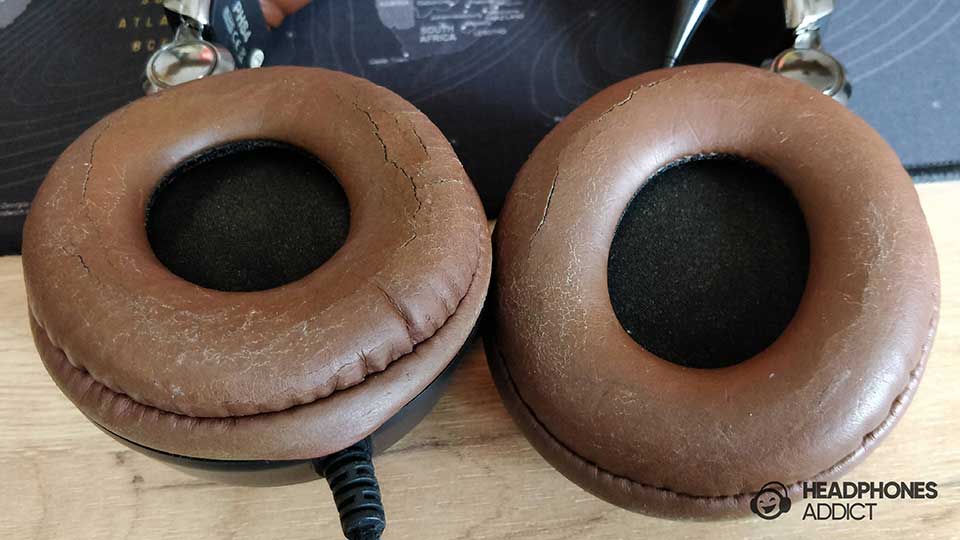
How to maintain real leather headphone earpads?
- Wipe your leather ear pads after use to remove excess sweat and moisture
- Once a year, apply a leather conditioner on earpads to avoid surface cracks
- Don’t expose your headphones to extreme temperatures (avoid direct sunlight)
Unlike synthetic leather, the real one is porous, absorbing everything that stays on its surface for too long. Including sweat, which is why, ideally, you should brush the earpads every time you stop listening.
If sweat finds it’s way into the leather, it eventually starts to smell. For better effect, wipe the earpads more thoroughly with a moist cloth once a week.
To avoid cracks on the leather, use a leather conditioner for sofas or car seats. It’s fine if you do that every year or so. However, don’t overdo it. If you moisturize the leather too much or too often, you can speed up the rotting process (you can see specks forming on the leather). Here’s more info on how to take care of leather.
Cooling gel ear pads
Cooling gel headphone ear pads have gel with cooling properties on top of foam. The gel is cool the to the touch and conducts temperature really well. It’s supposed to keep your ears cooler for longer.
They’re marketed as a solution to hot ears, but…
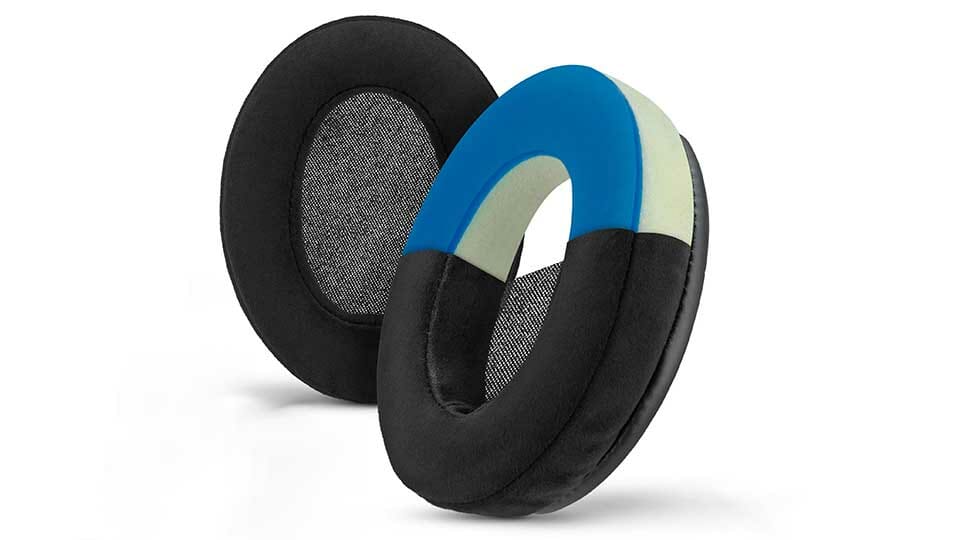
Are cooling gel ear pads worth it?
The cooling gel ear pads only stay cooler for the first hour or so. After that they tend to get even hotter than regular ear pads. The gel stores heat and then starts radiating it back. So, for extended use, cooling gel pads also get hot. And because the material is less ventilating, it keep the temperature up.
Good ventilation is a better alternative for keeping your earpads cool over long hours. So, look for loosely knit, breathable fabric ear pads that have great ventilation.
Memory foam vs regular foam ear pads
- Memory foam filling slowly regains its original form when pressed with fingers.
- Contrary, regular foam jumps back immediately.
There’s a minimal difference at best. Memory foam is slightly better at adjusting to your ears and thus more comfortable than regular foam.
Other unique types of earpads
When browsing through headphones, some of them are using proprietary materials for headphone ear cushions. For example, Grado headphones only use a straight foam cover. It’s a porous material that doesn’t impact sound much, doesn’t block noise well, and is prone to dirt accumulation.
You can also find micro suede ear pads. These are similar to fabric with a suede-like finish.
Others call their ear pads hybrids. Usually, a combination of different materials. Personally, I’d stay careful believing in all the “benefits” compared to common types.
Ear Pad Shapes and Sizes
Earpads shapes:
- Oval
- Round
- Rectangular shape with rounded corners
Most headphone ear pads are oval because that’s the best shape that fits around the ears.
But you can also find perfectly round and somewhat rectangular shaped earpads.
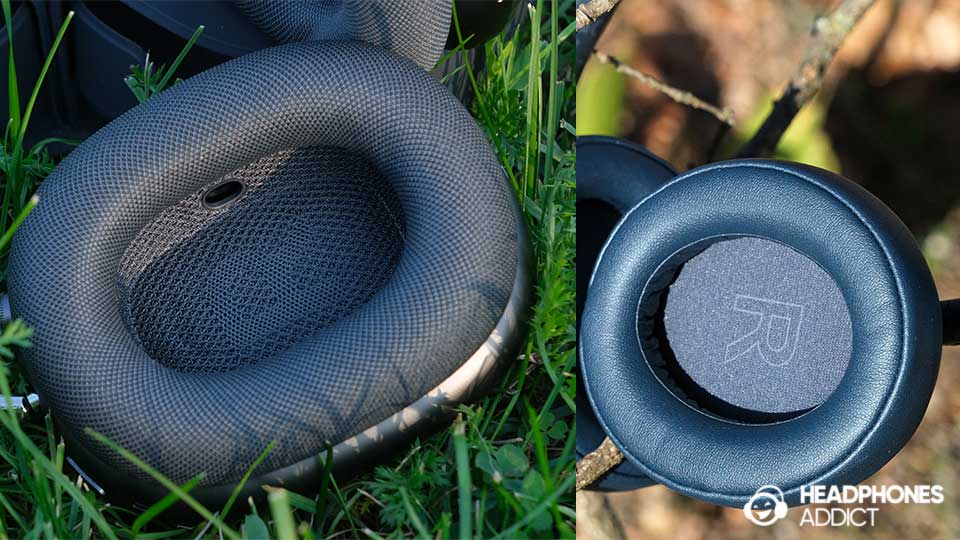
There’s no major difference in comfort between different shapes of ear pads. The only thing that matters is the thickness and size. The earpads have to be big enough to go around your ears without touching your earlobe.
Headphone pads that touch your earlobe tend to become painful over time.
This is why on-ear headphones with smaller ear cups and pads tend to be less comfortable. So, for comfort, choose over-ear instead of on-ear headphones.
Does the shape of ear pads impact sound quality?
Some audiophiles claim that differently shaped ear pads change the sound quality. And technically that is true. But since the earpad shape follows the headphone earcups, and you can’t change the earcup shape, it’s impossible to properly fit differently-shaped pads on the same headphones.
Some people try a DIY solution, but I’d advise against it unless you know what you’re doing.
If you’re trying to make your headphones sound better, equalization (EQ) is much easier.
How Ear Pads Affect Your Headphones?
Headphone ear cushions dramatically affect the overall experience with your headphones. Specifically comfort, noise isolation, and audio quality.
Earpads affect comfort
Earpads are always in contact with your skin, making the listening experience either enjoyable or unbearable.
- Thick pads with soft foam can make any headphones comfortable. Sufficient padding in thicker pads is better since they leave more room between your ear and foam covering the driver.
- Fabric and velour are the most comfortable in hot climates since they’re breathable. They prevent your skin from heating up.
- Real and faux leather are also soft to the touch, but have poor breathability and tend to make you sweat around the ears.
- The shape of the headphone pads also plays a role. Over-ear pads surround your ears completely, without pinching ear lobes against your skin.
Headband cushion also affects comfort, but usually isn’t replaceable. What the headband can cause is headphone hair, which is a minor annoyance.
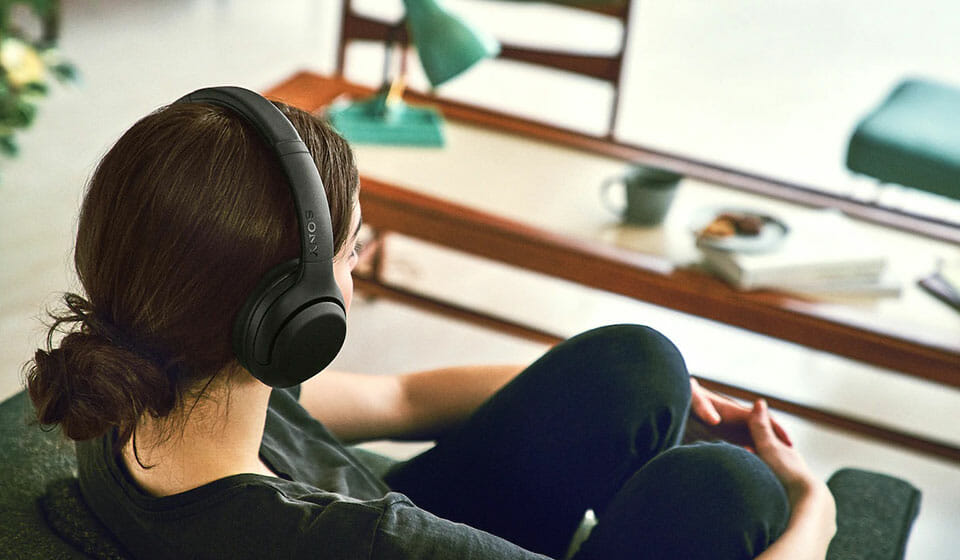
Passive noise Isolation
Headphones rely on their construction and ear pads to seal the sound in. If your pads let through a lot of noise, then your headphones suffer from sound leakage, intrusion from background noise, and lower bass response.
That is why the earpads need to grab around your ears snuggly. And you have to pick the right materials for the job (see above).
The best material for passive noise isolation is leather (faux and real) and thick fabric. By creating an airtight seal, it blocks any potential holes.
Velour isn’t as effective at blocking out noise, let alone prevent everyone around you to hear your music.
With age, the foam inside the ear pads condenses and stiffens. That prevents it from fitting your ears properly, letting in more ambient noise.
Earpads impact sound quality
Headphone ear pads also impact sound quality, particularly bass response. While drivers and housing are fundamental when it comes to the headphone’s sound signature, ear pads are the third component.
Manufacturers are very carefully picking the materials and the pads’ shape when trying to achieve a desirable result.
When the headphone pads start losing their shape, and the foam inside becomes stiff, the sound changes. The difference is subtle and accrues gradually, but at one point, headphones start to sound differently than before.
Most noticeably, the bass degrades because of the improper seal. Fine details can also fade away over time, which might not be a big deal for a casual user, but is very important for professionals working in a studio.
How to Change the Ear Pads
You need to change car tires after a couple of years because they lose grip. You should do the same with your earpads when they get old, dirty, and lose form.
When should you change earpads?
- When earpads start losing their shape and audio characteristics. Usually, the signs that we need to change the headphone pads are clearly visible. The memory foam inside becomes stiff and uncomfortable, and the outer material gets dirty.
- Leather can start to crack or even peel off.
- Velour is no longer soft and gentle but becomes hard as if all of that sweat throughout the years glued the fibers together.
- In some extreme cases, earpads start to rot and stink.
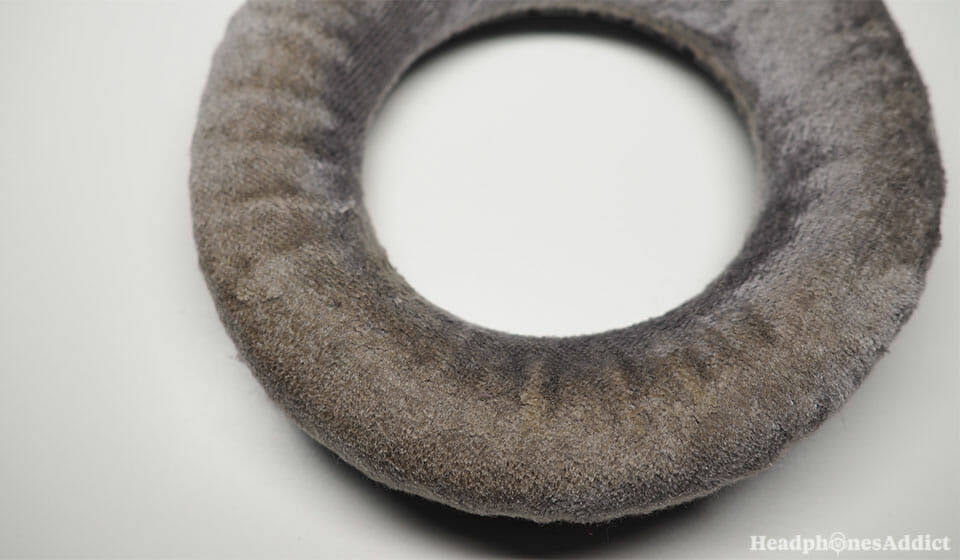
All of these signs are an indicator that you need a brand-new pair of headphone pads.
How often do you need to change the ear pads?
You need to change the ear pads when they start flaking or don’t offer the same support as before. It depends on how serious you are about the optimal performance of your wireless headphones.
Generally, with care, they can last for years. If you don’t use your headphones that much, you should probably change them every 2 or 3 years. Or when you start seeing wear and tear discussed above.
It’s similar to ear tips on in-ear headphones.
However, if you use your headphones for professional work, you should probably change the headphone pads every 6-8 months. If you use them daily, the foam inside gets stiffer much sooner. That changes the quality of the audio and, perceived details in the mix.
How to pick the right earpads?
If you want to restore the original sound and comfort of your headphones, try getting the original replacement ear pads. If the manufacturer doesn’t sell them anymore, look for ear pads with a similar type (the same material and shape).
You can also experiment with new earpads to see which ones work better for your headphones. Apart from fully leather or velour ones, there are also hybrids (mix of velour and leather). Some headphone pads are also angled to beam the drivers’ sound directly into your ear canal, increasing the perception of soundstage.
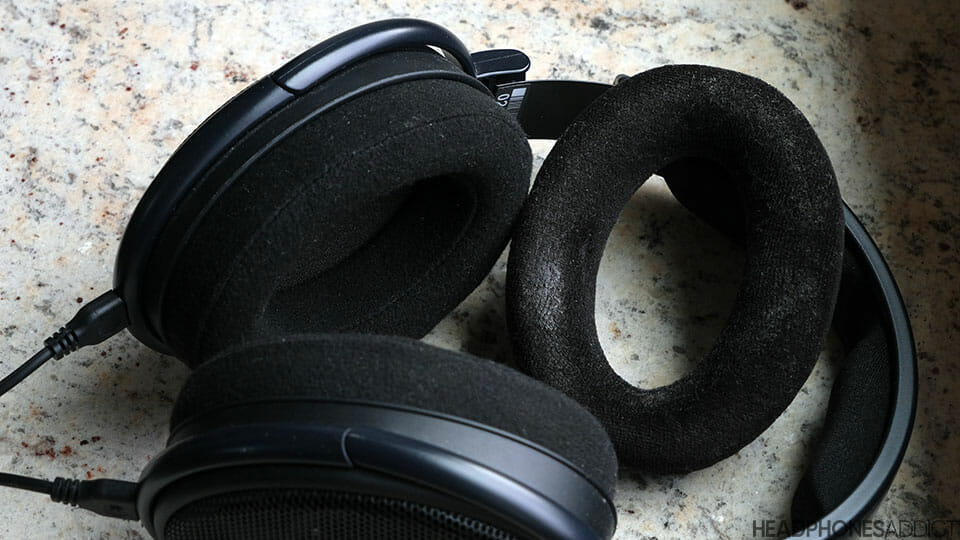
However, be aware that the shape and material of the earpads can change the audio significantly. If you try to experiment too much with other materials, you can end up with better-looking pads, but worse (or changed) sound.
Before buying headphone pads from a different manufacturer, check forums to see what others recommend for your headphones.
When buying from other manufacturers, find out how your existing earpads are locked in place.
- Some are easily attachable by twisting them onto the earcup
- Others have a plastic construction that needs to click into place
Unfortunately, there are also headphones that have permanently glued pads. You can still replace them, but it takes more knowledge (and patience) to do so.
Read more:
FAQs
What is an ear pad?
An ear pad is a cushion between the headphone drivers and your ears. It makes headphones comfortable to wear for humans creating a soft and comfy barrier between plastics and your skin.
Do ear pads affect sound quality?
Ear pads affect sound quality, especially the level of bass. Headphone cushion material is the most important aspect. Materials like pleather and thick fabric that offer good passive noise isolation improve the bass response.
Do ear pads make a difference?
Ear pads make a big difference in headphone comfort, passive noise isolation, and sound quality. Soft and thick pads offer superior comfort. Earpads with good passive noise isolation improve noise blocking and boost bass.
Are headphone pads removable?
Not all headphone ear pads are removable. Thankfully, most are easily replacable, but some headphones have them glued on. It takes technical work to replace them, but it’s still doable.
Why do headphone pads peel?
Headphone pads peel because of material deterioration. Faux, synthethic leather is prone to peel after a couple of years. This is a limitation of the material and can only be fixed by replacing the ear pads.
How do you fix peeling headphones?
Unfortunatelly you cannot fix peeling headphone ear pads. Once the pads start peeling and chaffing, the only way to fix it is by replacing them with new ones.
Are headphone cups universal?
Headphone ear cups are not universal. Some headphones have interchanging earpad size, but generally each headphones have a unique ear cup size. When buying replacement earpads, make sure you get the right size that fits your headphones.
Conclusion
Just like eartips in comfortable earbuds, ear pads play a crucial role in comfortable headphones.
You can have the best headphones in the world, if you don’t use the right ear pads, they won’t feel good on your head.
They’re a part that most often breaks or deteriorates to the point of needing replacement. While you can find ear pads for different purposes, we’re yet to see a universal type of earpads that would be the best for everything.
What are your experiences with ear pads? Let us know in the comments below.

From a childhood fascination with sound, Peter’s passion has evolved into a relentless pursuit of the finest headphones. He’s an audio expert with over 5 years of experience in testing both audiophile and consumer-grade headphones. Quote: “After many years, I can confidently tell which headphones are good and which are terrible.” Find his honest opinion in his reviews.


